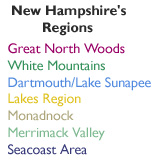Bugs in New HampshireLucie’s View on the Bug Season
First of all, depending on the activity, elevation, location, and for most of the year, we will not encounter many insects on outdoor adventures. As far as human pests, during summer we are most likely to see–if anything–mosquitoes, black flies, no-see-ums, and ticks. We don't let these little critters deter us from our awesome outdoor activities--precautions are a part of everyday duties. There are concerns that mosquitoes may carry West Nile Virus (among other things) and that ticks may carry Lyme disease and other bacteria. Black flies (highest population in June) are annoying and cause itching for a few days; no-see-um bites feel like a mini deer/horse fly bite and they both may contain bacteria as well. There are reportedly black widow and brown recluse spiders, but I have never seen them. During the bug season, about May to September, I recommend covering skin areas with clothing as a first line of defense–at least while in camp. It has been reported that tests have shown the colors of light green, khaki, and tan to be the some of best biting insect repellents as far as clothing choices. It has also been reported that most biting flies are attracted to colors like light blue, dark blue, and especially black. We are usually not bothered by mosquitoes and black flies while hiking at cooler higher elevations, moving on bicycles, on the water in canoes and kayaks, or when it’s windy. To spot ticks better, it’s a good idea to wear light-colored clothing and tuck pants into socks and shirt into pants, because ticks like to climb upwards and will attach themselves onto any part of the body. Checking for ticks and signs of tick bites daily during and after your trip is recommended. When it’s too hot for wearing a layer of bug clothing, insect repellent is an alternative (and should probably be worn at all times to keep ticks off). There are several products available and I’m not endorsing or approving any particular one. Some ingredients have been researched, tested, and “approved by the government” and others are wives’ tales such as eating garlic or bananas. I’ve heard that soldiers use a mixture of half SkinSoSoft (Avon) and half rubbing alcohol. Avon also offers various products that combine SSS repellent and SPF for sun protection. For longer protection, there are now three ingredients approved by the government to ward off mosquitoes and ticks: DEET (in Off! Deep Woods), and a couple natural NON-DEET ingredients–picaridin (in Cutter Advanced Insect Repellent Pump Spray with Picaridin), and the oil of lemon eucalyptus (in Repel Lemon Eucalyptus Lotion Insect Repellent / Fite Bite Plant-Based Insect Repellent). Studies also show that Bite Blocker for Kids (containing soybean oil) is also effective for a shorter period of time. Some mothers attach a sheet of fabric softener to a child’s hat to ward off bugs. One of our guides swears by “Twenty drops of cedar bark oil to one tablespoon of flax seed oil.” My mother-in-law uses something she calls “lavender oil,” but my daughter is allergic to one of the ingredients. Okay, so whatever works. One sure thing is, if you book a trip between November and April, we can guarantee that you will not see any biting bugs in New Hampshire, and the fresh air smells so good! |
- Home
-
About Us
-
Activities We Offer
>
- Bicycle Touring & Mountain Biking
- Birding
- Canoeing & Kayaking
- Cross Country Skiing
- Dog-Friendly Adventures
- Fly Fishing
- Group Programs
- Hiking, Trekking, & Backpacking Guides in NH
- Moose Tours in New Hampshire
- N.H. Nature & History
- North Woods Survival & Backcountry Skills
- Outdoor Photography
- Primitive Survival Skills at High Meadow Farm
- Self-Guided Outfitted Adventures
- Sightseeing Tours in New Hampshire NH
- Snowshoeing
- Target Archery
- Our Guides
- Why Us?
- Testimonials
- In the News
- Pictures & Quotes
- Blog
-
Activities We Offer
>
- Private Guided ESCAPES
- Events: Join a Group
- Booking Info
- FAQs
|
Outdoor ESCAPES New Hampshire, LLC
Guided adventures, nature tours, and outdoor education for all ages and abilities. Office: P.O. Box 104, Freedom, NH 03836 U.S.A. For questions, reservations, and directions to meet us, please see Booking Info page, call Lucie Villeneuve (603) 528-0136 or Jeff Barrie (603) 867-3778 or Contact Us any time! |
Home | About Us | Activities We Offer | Guided Day Trips | Multi-day Packages | Group Programs | Events | Booking Info | Getting Here | FAQs
Copyright © 2003 - 2024 Outdoor ESCAPES New Hampshire, LLC. All rights reserved.
Our outdoor guide service company serves New Hampshire residents as well as visitors from around New England, U.S.A, Canada, and Worldwide.
We are only a few hours drive from Manchester, Portland, Boston, Burlington, Montreal, Quebec City, Providence, Hartford, New York, and Philadelphia.
Our outdoor guide service company serves New Hampshire residents as well as visitors from around New England, U.S.A, Canada, and Worldwide.
We are only a few hours drive from Manchester, Portland, Boston, Burlington, Montreal, Quebec City, Providence, Hartford, New York, and Philadelphia.

